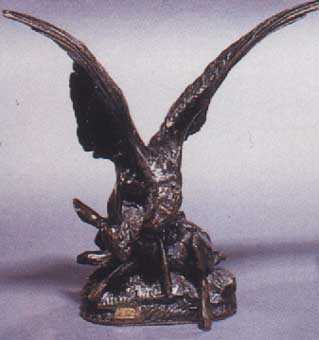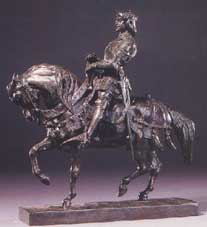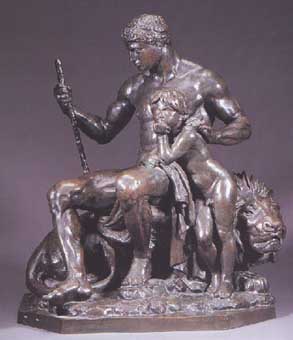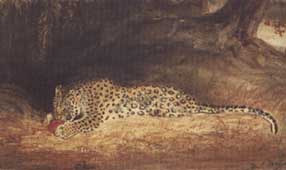|
Great Masters
BARYE ANTOINE-LOUIS
Date of birth : 1795-1875
Nationality : French
Activity : Sculptor
Average price : Between US $ 1,000and 70,000
|
 The son of a goldsmith Barye started to work at 13 as an apprentice to an engraver and then for Bicunais, a goldsmith. Such apprenticeship enabled him to discover the secrets of metals, notably foundry and chiselling methods. The son of a goldsmith Barye started to work at 13 as an apprentice to an engraver and then for Bicunais, a goldsmith. Such apprenticeship enabled him to discover the secrets of metals, notably foundry and chiselling methods.
Barye then worked in 1816 with Bosio, a sculptor, and studied at the school of Beaux-Arts in Paris from 1818 until 1824. In 1820 he was awarded a second prize medal with a sculpture entitled "Cain cursed by God" and started to earn a living working for Fauconnier, a goldsmith for whom he produced small-size animals.
Barye however found his main source of inspiration in the gardens of the Paris Natural Museum (Jardin des Plantes) where he studied captive animals and took a keen interest in anatomy.
He faced many difficulties during his career, notably in 1848 when his patrons demanded the reimbursement of a considerable sum of money and seized all his models in return. Appointed as head of the department of plaster moulds of the Louvre Museum in 1848, Barye gave up his job two years later in favour of Nieuwekerk. He then taught drawing at the Museum of Natural History in 1854 and was awarded the medal of the Légion d'Honneur the following year. Elected at the French Academy in 1868, he sought refuge in Cherbourg during the 1870 Franco-Prussian war and returned to Paris in 1871.
|

Brown patinated bronze equestrian group entitled "Charles VII Victorieux",
last quarter 19th Century, signed Barye, F. Barbedienne, Fondeur
|

A French green/reddish brown-patinated
bronze grop entitled "La Force",
signed Barye, F. Barbedienne, Fondeur |
Barye started to exhibit his works in 1827 at the Paris Salon and obtained a second prize in 1831 with his Tiger devouring a Gavial. Still art critics snubbed him and considered his representations of wild animals as mere paper-weights. As a result his Lion at Rest was refused at the 1836 Salon and Barye waited 14 years before being allowed to show his works there. He eventually met success with his Theseus fighting against the Centaur Bienor and took part in the 1855 Universal Exhibition where his Jaguar devouring a hare earned him a first prize.
During his career this artist however benefited from the support of the Duke of Orleans in 1834 and produced some monumental pieces for the French State. He also created allegorical figures and created a Napoleon dressed as a Roman Emperor in 1860-65 as well as relief works.

Antoine-Louise Barye, "The leopard's meal", about 1835
watercolor, ink and gouache on paper, 14,3x23,2 cm
Barye was perhaps the greatest sculptor of animals during the 19th Century and gave his subjects some of the most real attitudes. He also produced some stunning watercolours representing animals but abstained from showing them in an Orientalist style. In addition, he was one of the first painters who worked in the woods of Fontainebleau where he produced some charming paintings under the influence of Théodore Rousseau, Diaz and Millet. Thanks to his œuvre, animals were given a major importance in art as they were represented in their full ferocious reality. His works were shown in a retrospective exhibition in the Louvre Museum in 1996.
Main results for Barye's bronze sculptures :
Panther of Tunis, 9.5 x 19 cm: US$ 750, April 1st 1998, PIASA, Drouot-Paris
Jaguar devouring a hare, 14 cm: $ 3,570, May 3rd 1998, Galateau, Limoges, France
Panther attacking a deer, 39 x 56 cm: $ 6,250, July 5th 1998, Pillon, Calais
Theseus fighting the Centaur Bienor, 55.5 x 55 x 25 cm: $ 8,930, July 5th 1998, Blouet, Mayenne, France
Charles VII victorious, 29 x 23 cm: $ 3,482, July 7th 1998, Delavenne, Drouot-Paris
Theseus fighting against the Centaur Bienor, 34 cm: $ 10,357, April 8th 1998, Million, Drouot-Paris
Basset Hound, 16 cm: $ 18,125, October 9th 1998, Juge, Angouleme, France
Tiger getting an antelope by surprise, 33 x 52 cm: $ 8,570, April 12th 1998, Galateau, Limoges
Theseus fighting against the Minotaur,Barbedienne founder, 61 cm: $ 35,000, March 18th 1998, Sotheby's New York
Elephant from Senegal, 14.5 cm: $ 7,145, May 18th 1998, Tajan, Drouot-Paris
African Horseman surprised by a snake, 23 x 29 x 18 cm: $ 25,000, November 26th 1998, Savot, Orleans, France
Lion and snake, 1816, 27.4 cm: $ 10,000, December 3rd 1998, Christie's New York
Lion devouring a dog, 1837, 14 x 30.8 cm: $ 16,000, May 8th 1998, Sotheby's New York
Tartar warrior, 37 x 37 cm: 14,020, November 9th 1997, Pillon, Le Touquet, France
Gaston de Foix, 34.9 cm: $ 6,500, January 9th 1997, Sotheby's New York
Turkish Horse, right anterior leg raised, 28 cm: $ 25,357, March 13th 1997, Crédit Municipal, Paris
General Bonaparte on his horse, 35.5 x 32.5 cm: $ 8,930, November 19th 1997, Briest group, Drouot-Paris
War and peace, two bronze sculptures, 50.2 cm each: $ 49,000, October 23rd 1997, Sotheby's New York
Theseus fighting the Centaur Bienor, Barbedienne founder, 1850, 75 x 67 cm: $ 17,860, December 14th 1997, Pillon, Calais
Please note that prices depend much on the dates during which models were cast. Pieces produced by Barye himself before 1860 are much sought. Those cast by Barbedienne and other founders of the 19th century are also fetching high prices.
|
|